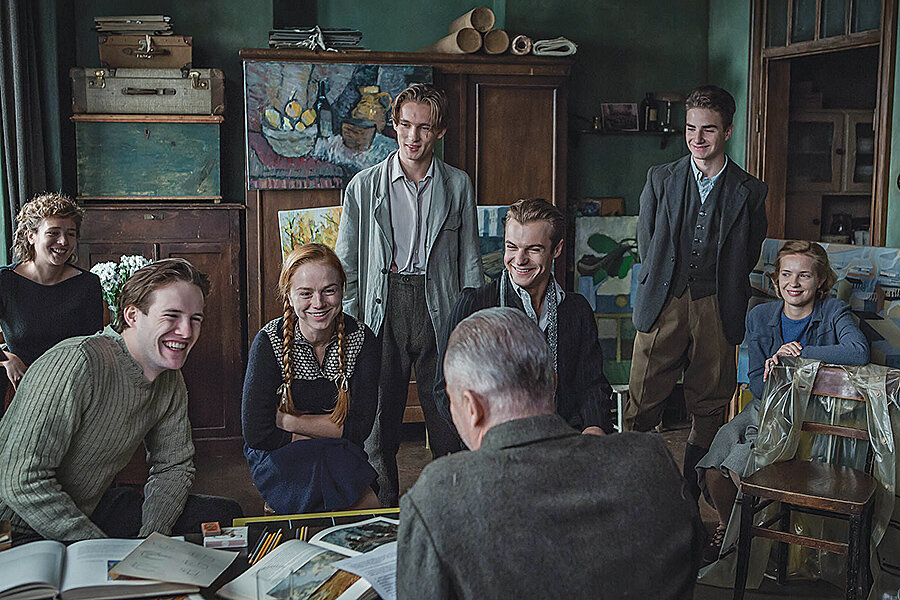In intensely harrowing 'Afterimage,' Stalinist repression shatters artist’s life
Loading...
The Polish avant-garde painter Wladyslaw Strzeminski, whose life was shattered by Stalinist repression, is the subject of Andrzej Wajda’s final film, “Afterimage.” (The director died last year at the age of 90.) It’s intensely harrowing – a fitting coda to the career of a director whose own work often clashed with Communist ideology.
Strzeminski, as portrayed by Wajda’s longtime actor Boguslaw Linda in a magisterial performance, lost a leg and arm fighting in World War I, and yet his passion for the transformative powers of art makes him whole. His injuries are merely a nuisance to be endured.
The dictates of the Communist Party in Lodz, Poland, where he cofounded the art school where we first see him teaching in 1948, are another impediment he attempts to brush aside. But although he is a revered figure in the Polish art community, with a classroom packed with adoring students, his painterly abstractions are toxic to the Communist authorities, who castigate as capitalist decadence all art that is not uplifting social realism.
There is a remarkable sequence early on in “Afterimage” that captures with comic horror Strzeminski’s impending martyrdom. While he is painting alone in his study, the room is suddenly bathed in red light. It takes him a moment to realize the reason: a bright red banner of Stalin unfurled outside his window during a parade. With calm deliberation, he opens the window and jabs a hole in the banner to let the light in. This, of course, brings the authorities to bear on him. “You are at a crossroads,” an official tells him. He is instructed that if he does not conform, “you bring that fate upon yourself.”
It is both Strzeminski’s glory and tragedy that he is not capable of revising his fate. His stand against the Communist authorities goes way beyond simple pride. To comply with the state’s demands for social realist art that is synonymous with propagandistic kitsch would be for him a violation of nature itself.
Strzeminski, as Linda plays him, has the obsessive insularity of someone who has little need for the comforts of companionship. He is estranged from his wife, the celebrated sculptor Katarzyna Kobro (Aleksandra Justa); their teenage daughter, Nika (Bronislawa Zamachowska), shuttles between the homes of both parents. When she goes to live with him after her mother’s death, he is so peremptory that she retreats to a children’s home. He comprehends her dutifulness and her entreaties to take better care of himself, but he doesn’t have the mettle to abide her for long. “She will have a hard life,” he says sadly after she leaves. (She departs stoically but then we see her crying in the street as she flees.) It’s the closest thing to a benediction he utters in the entire movie.
Wajda and Linda refuse to sentimentalize Strzeminski’s plight. If, as a smitten student says, he is a “prophet,” he is a self-
immolating one. And yet we understand that his capitulation to the authorities would be an even greater calamity. This almost happens. Barred by the Workers Party from buying art supplies, or even food, he refuses a deal with the bureaucrats to renounce his beliefs and then, in desperation, scrounges a low-level warehouse job painting heroic posters of Stalin. But his insubordinate past catches up with him. His last job, before he dies from tuberculosis, is dressing mannequins in a store window.
The irony of “Afterimage” is that it champions an avant-garde artist, warts and all, and yet Wajda’s stylistics here are conventional and understated. His movies (including the celebrated “Man of Marble” and “Man of Iron”) have often been bulky and jampacked. By comparison, “After-
image” is devastatingly concise. Each fresh outrage perpetrated against Strzeminski is recorded with a thudding finality. The enclosing trap set by the state has a sickening inevitability. Wajda brings such a controlled fervor to this portrait because it’s clear that, like Strzeminski, he identifies as a dissident in dangerous times.
The final films of famous filmmakers are often misguidedly referred to as swan songs, as if the directors knew this film would be their last and so put everything of themselves into it. Alas, the movie business does not often accommodate such tidy closures, but I can think of a few examples – John Huston’s “The Dead” is a prime candidate – in which a director’s final film was indeed, consciously or not, a kind of spiritual summation. And so it is with “Afterimage,” a movie about a man whose fate stands as a condemnation of so much that is abhorrent in the wider world. Grade: A (This movie is not rated.)







